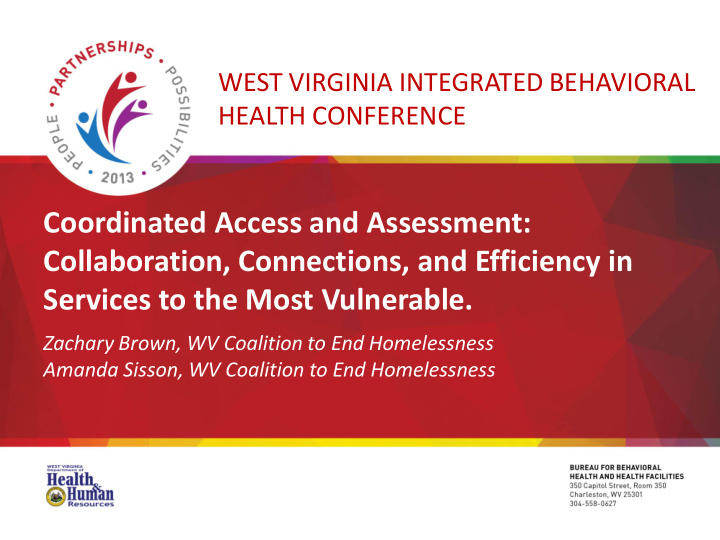



WEST VIRGINIA INTEGRATED BEHAVIORAL HEALTH CONFERENCE Coordinated Access and Assessment: Collaboration, Connections, and Efficiency in Services to the Most Vulnerable. Zachary Brown, WV Coalition to End Homelessness Amanda Sisson, WV Coalition to End Homelessness
Learning Objectives • List the key elements of a working Coordinated Access/Assessment system. • Understand the need for Coordination among those serving the most vulnerable populations. • Embrace the critical role of prioritization. • Identify barriers to a Coordinated Access System. • Realize the resource implications of Coordination.
The Basics • Getting away from “first come, first serve”. • Measuring acuity. • Acting quickly. • Efficiently using the resources at hand. • Informing the type and geography of additional resources.
Potential Models • Centralized • Decentralized • Telephone/Online Based • Mobile • Mixed
Questions • Do we now have a consistent process for grasping housing and service needs? • Are housing opportunities and services linked in a meaningful way? • Do we move quickly and effectively as a state/community?
The Cardiac Question • Let’s explore your options for cardiac care: 1. Gynecologist 2. Cardiologist 3. Couch Potato who loves Medical Shows
The Essential Question Not, does this person/family fit into my program , but… what housing and services does this person/family need that our (combined) programs can supply?
What we do now
What we do now Current Practice is program centric. Guiding Question : “Should we accept this family into our program?” • Unique forms and assessment processes to each organization. • Ad hoc referral process between programs. • Uneven knowledge about available housing and service interventions in the community.
What we need to do
What we need to do Client-centric. Guiding Question : “What housing and service assistance is the best for each household of the several services available?” • Standard forms and assessment processes used by every program for every client • Coordinated referral process across the CoC or state • Accessible information about available housing and service interventions in the CoC • Prioritization and expedient referral
Homeless Population – Not Homogeneous “Funnel” Of Homeless Services Intake & Assessment – Acuity Determined
It’s about the client Saves time and effort (no traveling from place to place, no transportation hassles if the system is telephone or HMIS-based, no need to find day care for children) Makes intakes and assessments more accurate (uses standard intake, screening and eligibility tools, giving a complete picture of the client’s needs and referral options) Results in more appropriate referrals (refers clients to the resource most appropriate for the client’s need, and the most cost-effective intervention
So, the process becomes… 1. Person or Family presents at shelter, outreach, DHHR Office, etc. 2. Diversion is attempted. 3. Shelter Admission if Diversion is Unsuccessful. 4. Minimal Service (housing encouragement for 14 days). 5. Housing Triage (Pre-Screen). 6. Determine Acuity. 7. Place in Housing First, Rapid Re-Housing, No Housing Assistance based on acuity.
The Process is not… • Haphazard. • Based on the application of external values • Based on available service/program slots • Based on chronology (first come, first serve) • Based on “gut instincts” about an individual or family’s next steps (either from over or under - response to crisis)
Determining Acuity • Based on a series of dimensions. • Takes into account: History of Housing and Homelessness Risks (Health, Mental Health, Crisis, Legal, Social Situations) Socialization and Daily Function Wellness (Physical Health)
Determining Acuity • Let’s take a look at the VI -SPDAT Prescreen to see some questions attached to dimensions: http://100khomes.org/blog/introducing-the-vi- spdat-pre-screen-survey
What does this mean for the most vulnerable? • Shorter time from street or crisis to housing and stability. • Connection to the most effective options. • Prioritization in the system!
What does this mean for the most vulnerable? • Prolonged life. • By understanding risks to housing stability, we are better able to promote homelessness proofing.
The Process Guides the System • Do the existing resources match the needs in the aggregate? • If they do not, where are the gaps in services and housing? • Can we track referral outcomes better?
The Process Informs Change • What are the most prevalent needs- Geographic? Housing? Services? • Do we have duplication of effort? • Do we have low performance? • Are we screening out?
Change Leads to Improvement • Prevention of Homelessness and Crisis • Diversion from Shelters • Housing of the most vulnerable persons who will die on the street • High Barrier persons placed in the higher cost programs meant for them • Low Barrier persons received “light touch” (progressive engagement) or solve their own homelessness
In Short • We can transform the currently disjointed system into one that is effective, efficient, saves money, and changes people’s lives for the better.
Contact Zach Brown WVCEH Executive Director Ph. 304-842-9522 zachbrown@wvceh.org www.wvceh.org www.facebook.com/wvceh Twitter: @wvceh Amanda Sisson WVCEH Administrative Officer/Data Analyst amandasisson@wvceh.org
Recommend
More recommend